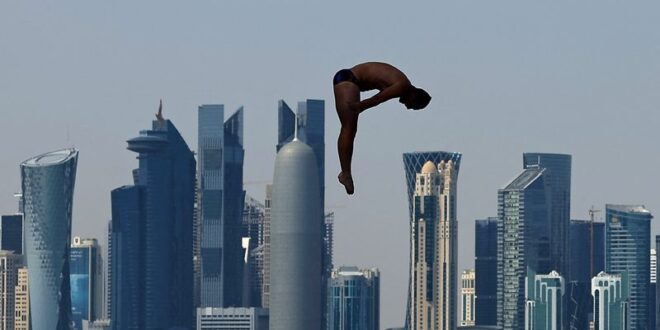DOHA (Reuters) – A 27-metre platform perched above the Doha Old Port was Aidan Heslop’s launchpad for a first high diving world championship title which one day the Briton hopes may be a milestone on the way to an Olympic gold.
Heslop’s final dive on Thursday was a thing of vertiginous beauty — a forward launch, four somersaults and three-and-a-half twists pike rated the toughest in the business.
Straight as a pin on a feet-first entry into a six-metre deep tub, the 21-year-old from Chelmsford nailed the dive with barely a splash, triggering a roar from a healthy crowd in temporary terraces and a huge score of 151.90.
He had a nervous wait as the final divers sought to dislodge him from the gold medal position.
In the end, though, he finished just clear of France’s runner-up Gary Hunt and hirsute Romanian, Catalin-Petru Preda, who took the bronze.
“As soon as I put that last one down, I thought I had a good chance, but you can’t leave these things to chance,” Heslop told Reuters.
“It’s pretty nerve-wracking, standing and watching. We’ve all been in that situation before.”
Simply watching as a spectator can be nerve-wracking.
Though buffeted by a stiff sea-breeze and with a drone-camera buzzing nearby, divers performed hand-stand launches from the edge of the platform.
The margins between success and painful failure seem razor-thin — but there are relatively few wipe-outs at the elite level.
They mercifully enter the pool with their feet rather than head-first and pretty much all high divers have a background in the regulation diving seen at the Olympics, where the highest platform is 10 metres.
Heslop, who dived for Wales at the Commonwealth Games, is confident he will be high diving for Britain at the Olympics eventually.
“I don’t hope high diving will be there. It’s going to be there. I’ll be there, I reckon at Brisbane,” he said of the 2032 Games.
“When you look at the progression of this sport, in the last five years it’s just been phenomenal.”
OLYMPIC PUSH
Though a niche discipline within a niche sport, high diving has plenty going for it.
It looks spectacular on screens and as a spectator. Virtually made for the social media age, dives fit neatly into share-able short videos.
It would also seem to fit with the International Olympic Committee’s (IOC) push for youth, which has seen surfing, sport climbing and skate-boarding added to the programme at recent Games.
Global governing body World Aquatics (WA) added high diving to its World Championships programme in 2013 and is lobbying the IOC to add it to the Olympics.
WA will stage three high diving events on its 2024 calendar, two more than usual.
“Olympic inclusion is always a complex topic, but we have already made our case to the IOC and remain hopeful for the future,” World Aquatics Executive Director Brent Nowicki told Reuters.
The Olympic programmes are settled for this year’s Paris Games and Los Angeles in 2028 but a 2032 debut might offer enough time for high diving to grow and work on its IOC pitch.
Eighteen nations competed in the men’s and women’s high diving competitions in Doha.
Many of the divers may no longer be in the sport by 2032 but will gladly cheer on the next generation.
High diving, after all, is punishing on the body, said 39-year-old silver medallist Hunt, who won two world titles for Britain before switching allegiance to France a few years ago.
“Every off-season, getting back into shape is harder and harder,” he told Reuters.
“I still feel good, so I still want to go for at least another two years.”
(Reporting by Ian Ransom in Doha; Editing by Christian Radnedge)
 BeritaKini.biz Berita Viral Terkini di Malaysia
BeritaKini.biz Berita Viral Terkini di Malaysia





